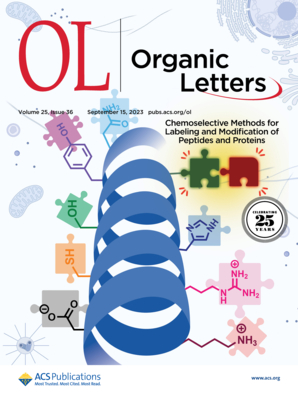二氯甲基(二芳基)磺酸盐作为宝石-二氯环丙烷化试剂
IF 5
1区 化学
Q1 CHEMISTRY, ORGANIC
引用次数: 0
摘要
宝石-二氯环丙烷是一系列工业部门中重要的结构基团,多年来一直是合成界相当感兴趣的焦点。然而,获取宝石-二氯环丙烷的合成方法仍然有限。为了解决这一挑战,我们报道了新的二氯甲基(二芳基)磺酸盐的开发,作为试剂,在温和的条件下,通过游离二氯甲烷途径将富电子烯烃的宝石-二氯环丙烷化,收率高达70%。这种方法提供了以前未报告的宝石-二氯环丙烷。本文章由计算机程序翻译,如有差异,请以英文原文为准。
Dichloromethyl(diaryl) Sulfonium Salts as gem-Dichlorocyclopropanation Reagents
gem-Dichlorocyclopropanes are important structural moieties in a range of industrial sectors and have been the focus of considerable interest within the synthetic community over the years. Synthetic methodologies to access gem-dichlorocyclopropanes, however, remain limited. To address this challenge, we report the development of new dichloromethyl(diaryl) sulfonium salts as reagents for the gem-dichlorocyclopropanation of electron-rich olefins via a free dichlorocarbene pathway under mild conditions in yields of up to 70%. This methodology provides access to previously unreported gem-dichlorocyclopropanes.
求助全文
通过发布文献求助,成功后即可免费获取论文全文。
去求助
来源期刊

Organic Letters
化学-有机化学
CiteScore
9.30
自引率
11.50%
发文量
1607
审稿时长
1.5 months
期刊介绍:
Organic Letters invites original reports of fundamental research in all branches of the theory and practice of organic, physical organic, organometallic,medicinal, and bioorganic chemistry. Organic Letters provides rapid disclosure of the key elements of significant studies that are of interest to a large portion of the organic community. In selecting manuscripts for publication, the Editors place emphasis on the originality, quality and wide interest of the work. Authors should provide enough background information to place the new disclosure in context and to justify the rapid publication format. Back-to-back Letters will be considered. Full details should be reserved for an Article, which should appear in due course.
 求助内容:
求助内容: 应助结果提醒方式:
应助结果提醒方式:


